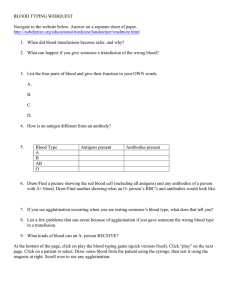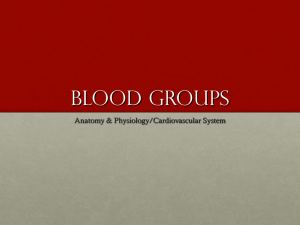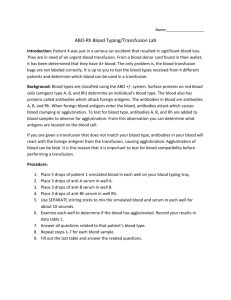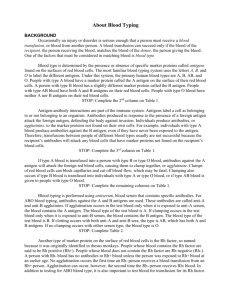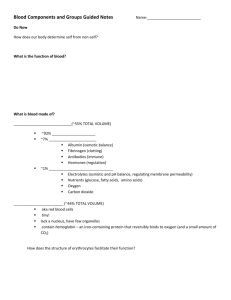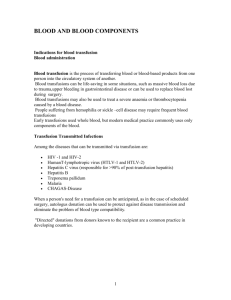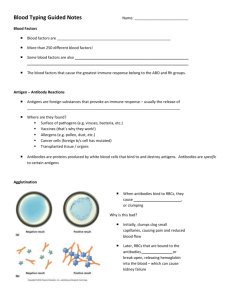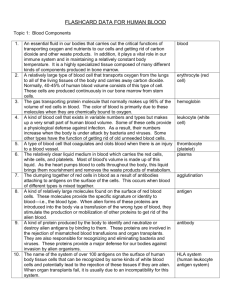Blood Groups - Jess - PBL-J-2015
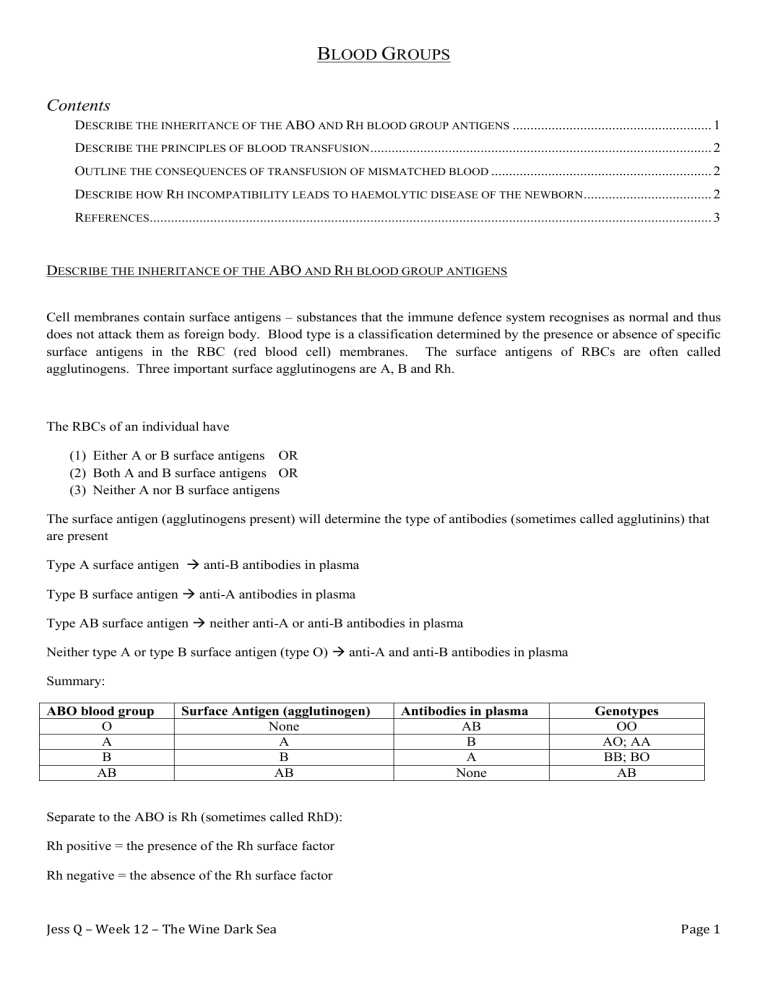
B
LOOD
G
ROUPS
Contents
D
ESCRIBE THE INHERITANCE OF THE
ABO
AND
R
H BLOOD GROUP ANTIGENS
Cell membranes contain surface antigens – substances that the immune defence system recognises as normal and thus does not attack them as foreign body. Blood type is a classification determined by the presence or absence of specific surface antigens in the RBC (red blood cell) membranes. The surface antigens of RBCs are often called agglutinogens. Three important surface agglutinogens are A, B and Rh.
The RBCs of an individual have
(1) Either A or B surface antigens OR
(2) Both A and B surface antigens OR
(3) Neither A nor B surface antigens
The surface antigen (agglutinogens present) will determine the type of antibodies (sometimes called agglutinins) that are present
Type A surface antigen anti-B antibodies in plasma
Type B surface antigen anti-A antibodies in plasma
Type AB surface antigen
neither anti-A or anti-B antibodies in plasma
Neither type A or type B surface antigen (type O)
anti-A and anti-B antibodies in plasma
Summary:
ABO blood group Surface Antigen (agglutinogen) Antibodies in plasma
O None AB
A
B
AB
A
B
AB
B
A
None
Separate to the ABO is Rh (sometimes called RhD):
Rh positive = the presence of the Rh surface factor
Rh negative = the absence of the Rh surface factor
Jess Q – Week 12 – The Wine Dark Sea
Genotypes
OO
AO; AA
BB; BO
AB
Page 1
E
XPLAIN BRIEFLY THE PRINCIPLES OF THE AGGLUTINATION REACTION
An agglutination reaction occurs when plasma that contains agglutinins attacks agglutinogens on “foreign” blood cells. When the agglutinins (antibodies), the foreign cells clump together – this process is called agglutination.
D
ESCRIBE THE PRINCIPLES OF BLOOD TRANSFUSION
What is it?
Basic principles of blood transfusion is when blood (or components of it – such as plasma) is taken from a donor and
(after screening for diseases etc), is given to a patient who needs additional blood.
Ideally, the patient receiving the blood will have the same blood type as a donor so that no transfusion reaction will occur from agglutinins of the donor attacking the agglutinogens from the recipient.
However, blood type O, that has no surface antigens, can be universally accepted.
How is it done?
To determine the type of blood of a recipient, blood typing (or grouping) occurs – where RBCs from recipient are mixed with antisera containing the carious agglutinins on a slide and observations are made whether agglutination occurs. This determines the ABO and RhD groups.
Cross-matching – RBCs from the donor are mixed with the recipients plasma to check for any agglutination – this checks for any antigen-antibody systems other than ABO.
O UTLINE THE CONSEQUENCES OF TRANSFUSION OF MISMATCHED BLOOD
There are multiple different consequences that can occur if transfusion is given with mismatched blood. The type and severity of reaction depends on the individual and the amount of mismatched blood that has been given.
Consequences can include: Agglutination (haemolytic transfusion reaction), bacterial infections, allergic reaction, vessel occlusion, embolic event is an example of a cross-reaction that can occur if mismatched blood is given.
D ESCRIBE HOW R H INCOMPATIBILITY LEADS TO HAEMOLYTIC DISEASE OF THE NEWBORN
1.
When an Rh- woman has her first Rh+ child, foetal and maternal blood mix at delivery when the placenta breaks down
2.
The appearance of Rh+ blood cells in the maternal bloodstream sensitises the mother, stimulating the production of anti-Rh antibodies
3.
If another pregnancy occurs with an Rh+ foetus, maternal anti-Rh antibodies can cross the placenta and attack foetal blood cells, producing haemolytic disease of the newborn
See diagram below
Jess Q – Week 12 – The Wine Dark Sea Page 2
R EFERENCES
Colledge, N., Walker, B., & Ralston, S (2010).
Davidson’s Principles & Practice of Medicine (21 st
Edition) .
Edingurgh: Churchill Livingstone Elsevier.
Martini, F. (2001). Fundamentals of Anatomy and Physiology (5 th
Edition) . New Jersey: Prentice Hall.
Sherwood, L. (2004). Human Physiology: From Cells to Systems (5 th
Edition) . Australia: Thompson.
Jess Q – Week 12 – The Wine Dark Sea Page 3

